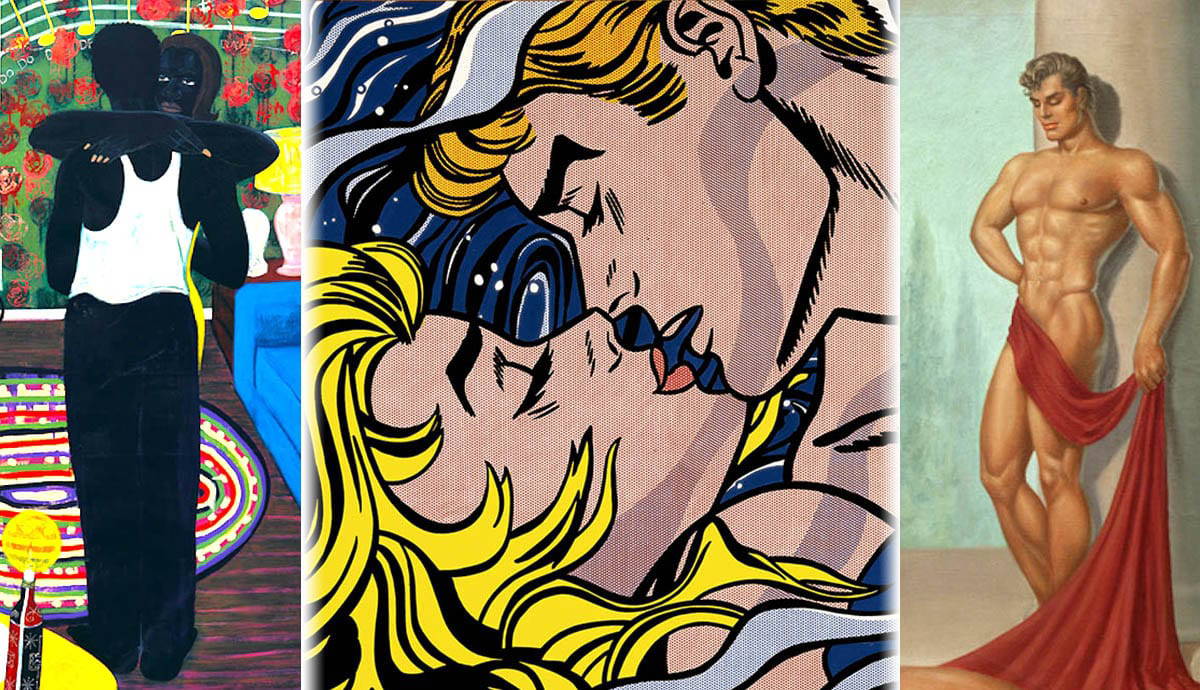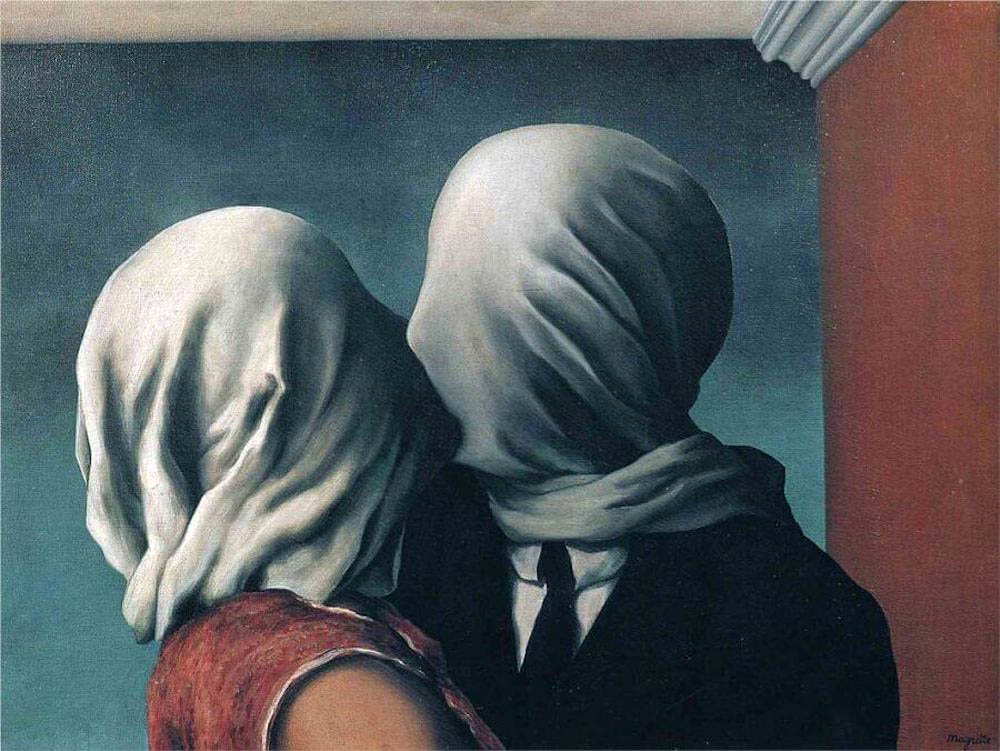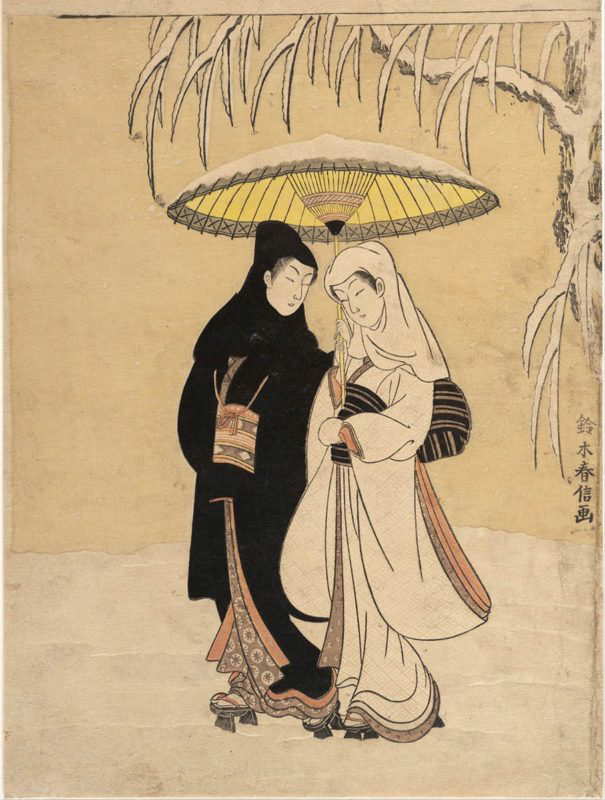
The art world is a mecca for both fictional and non-fictional lovers birthed onto vivid canvases. Humanity, as a whole, claims to promote egalitarianism, and yet, given current social and political upheavals, it has fallen short—again. Here are ten romantic paintings of lovers that cross social divides and echo the fundamental notion that under the surface, under the skin, where it matters, everyone bleeds the same.
10. The Kiss By Gustav Klimt

Although it ranks in at #10, the romantic painting The Kiss by Gustav Klimt is no mere runner-up. In fact, it is the archetype of human tenderness and desire. It represents passionate eroticism and how such eroticism consumes lovers—something most people can connect with.
The painting, born of Klimt’s “Golden Period,” features glittering gold tones, stylized strokes, and highly romantic visual allegory inspired by Byzantine mosaics. Notably, the eye-catching chief color includes detailing of gold leaf for effect.
The portraiture’s subjects are a couple sharing an intimate embrace, their bodies partially concealed by a majestic robe, as they kneel on wildflowers. The way the garment cocoons them is reminiscent of a bedsheet shared by lovers during and after consummation, symbolic of their heightened desire and eternal love. The expression on the woman’s face reveals her delight over being in her lover’s arms and receiving his kiss.
Get the latest articles delivered to your inbox
Sign up to our Free Weekly NewsletterHow this painting crosses social divides: It illustrates that once individuals are consumed by passion, they are spiritually unbound to this world and its limitations. They become one with the cosmos, which accepts all beings, regardless of genetics.
Interesting Fact:
At the time it was painted, The Kiss was viewed as pornographic material by post-Victorian society.
9. We Rose Up Slowly By Roy Lichtenstein

At first, this romantic painting of lovers might seem like an odd choice for the list. Yet when one delves into the context and artistic intentions, We Rose Up Slowly has more than earned its place.
All-American handsome hero meets pretty blonde heroine. Their “love” is so profound that the outside world has ceased to exist, and they do not even need air to breathe as they share a steamy underwater embrace . . . Indeed, it is a romantic notion and an appealing one. However, Roy Lichtenstein is actually mocking the superficiality of love here. The whole image is false and warped as it represents an illusion of “perfect love.” It is no accident that he designed it to look like an advertisement, making the painting serve a much deeper purpose: to expose the reality of how people “buy in” to such illusions in commercial form—and without really thinking about what it is exactly they are procuring.
How this painting crosses social divides: It blows the lid on love being limited to white, attractive, all-American stereotypes. By contrast, it reflects an industrialized nation that should know better, and yet still constantly “buys” a fantasy.
Interesting Fact:
For this canvas, Lichtenstein used a split panel composition between text and image. This was to blend the narrative between the two characters.
8. The Lovers II By René Magritte

The Lovers II is a work that, like We Rose Up Slowly, exposes the reality of love when it does not go as expected. On the one hand, it is a romantic painting of lovers sharing a close-up kiss. Yet, on the other hand, it’s a sad, almost haunting image. René Magritte was known for his themes of frustrated desires, so perhaps the veils wrapped around the subjects’ heads could be interpreted as such. They hinder the couple from engaging in a full kiss; instead, they are isolated and thus frustrated.
However, other interpretations are darker. Could this reflect a rejection, a denial of love? Does it represent relationships as a whole, and how they are often broken due to various issues, including a lack of communication?
How this painting crosses social divides: Stemming from the above interpretations, the artist might also be revealing in this image how no matter how close one might get to their partner, they will never know their true nature, which is represented by the barriers of cloth. For, as the saying goes, “Every man is an island.” Such a creative device plays on the reality that people often conceal themselves—they put on masks, only allowing others to see what is on the surface and not what lies deeper in their characters.

Interesting Fact:
When Magritte was fourteen, his mother committed suicide via drowning. He witnessed her body being retrieved from the water, with her nightgown wrapped around her face. It has been suggested that the artist’s common motif of enshrouded faces was born from this trauma. However, Magritte later denied this by stating, “My painting is visible images which conceal nothing. They evoke mystery and, indeed, when one sees one of my pictures, one asks oneself this simple question: ‘What does it mean?’ It does not mean anything, because mystery means nothing either. It is unknowable.”
7. Lovers in the Snow By Suzuki Harunobu

The poignant theme continues for this next romantic painting, which captures a quiet moment in time. A Japanese couple is strolling through snowfall in ai ai gasa pose, which means “to share an umbrella” or “love-love umbrella.” The umbrella itself can be interpreted as giving the scene extra intimacy. It is as if the viewer is almost interrupting the lovers’ walk. The fact that their expressions are solemn, almost sad, infers a potential loss or grief. The poet Noguchi even commented about the canvas: “If young Harunobu’s ‘Lovers Sharing an Umbrella’ did not exist, I would only wonder, what kind of lonely and desolate thing is this ukiyo-e of ours?”
How this painting crosses social divides: The tranquility of Lovers in the Snow embodies the Japanese aesthetic of wabi-sabi, which appreciates nature’s imperfect beauty. The couple represents young love, and like the characters in The Kiss and We Rose Up Slowly, they take advantage of their desire to be alone, untethered to the outside world, proving that, no matter one’s ancestry, everyone shares a similar experience of romantic love.
Interesting Fact:
Given the melancholic feel to this painting of lovers, it has been suggested that they are walking a michiyuki, a path to a love suicide.
6. The Jewish Bride By Rembrandt Van Rijn

Coming in at #6 is The Jewish Bride by Rembrandt van Rijn. This romantic painting of lovers got its name in the early nineteenth century after an art collector assuaged that it was a portrait of a Jewish father giving his daughter a necklace on her wedding day. However, this was later refuted, and the most popular consensus is that they are Isaac and Rebekah from the Old Testament.
The canvas shows an expression of love between the couple—a style rare for Dutch Realist artists during the Baroque era. The man has his left hand touching the woman’s shoulder in an affectionate gesture, while his right hand is similarly placed on her breast. This light physical contact indicates innocent love rather than lust. In contrast, the subjects’ miens hint at something deeper. The man’s eyes denote uncertainty, while the woman’s gaze implies contemplation. They are also not looking at each other. Could this hint doubt over their future?
How this painting crosses social divides: Like other paintings, The Jewish Bride can be interpreted as fusing spiritual and physical love. However, it also allows some falsehood as it’s an inauthentic image of a Jewish bride and bridegroom from the Bible. Instead, it’s an embellished romanticized portrayal of a cultural rite beyond a principally Christian society’s experience.
Interesting Fact:
Vincent van Gogh was so overwhelmed by the painting that it brought him to tears. He claimed that he would give up ten years of his life just to sit and admire it for two weeks while eating nothing but stale bread.
5. Romance By Thomas Hart Benton

Romance almost does not need an explanation regarding how it crosses social divides. This romantic painting of lovers shows a young, well-dressed black couple casually going for an evening stroll on a homestead. The artist, Thomas Hart Benton, was a painter, muralist, and patriot known for his country-themed scenes, which depict the American heartland, namely in the Southern, Midwestern, and Western states. His goal was to portray the hard work, autonomy, and overall satisfaction of individuals post-World War I.
How this painting crosses social divides: Benton used his art to generate social and political reform. Here, the subjects are portrayed as being content with their daily life. They carry a poignant style of walk, holding hands as their feet almost lift off the ground—a love-like disposition that anyone in a romantic relationship can relate with.
Interesting Fact:
Benton also had a knack for landscaping. His daughter, Jessie Benton, once told an interviewer for Smithsonian Magazine that it was her father who crafted the magnificent stairway and boulder-clad retaining wall to the family pond. “He built the wall and all that stonework himself so that we could walk down to our boat or go swimming . . . [the pond] This was our world.”
4. In Bed, The Kiss By Henri De Toulouse-Lautrec

This next romantic painting of lovers warrants a spot in the top five due to its erotic and sensual display. The subjects are female, with the artist bearing witness to their adoring embrace in bed—one that most viewers would be familiar with. Unsurprisingly, Henri de Toulouse-Lautrec drew this from real life. He had a great fascination with the 1890’s Paris nightlife, including its prostitutes. He would visit brothels and paint the everyday scenes he observed in them. Most had limited beds, so women shared—which often led to blossoming romantic relationships. One brothel even commissioned Toulouse-Lautrec to decorate its salon, and he was accepted as a friend and allowed to sketch the girls in their natural state—“off the clock” from their heterosexual male customers.
How this painting crosses social divides: It depicts love outside previously accepted social norms. The two women cling to each other, intertwined as if they are afraid of being separated—could this be a reflection of the time and how lesbians were shunned by society? A blog by Secret Lesbians sums it up impeccably: Lautrec was trying to capture small, tender moments in the lives of the women he met, and he did so with humanity and sensitivity. In a world of constructed sexuality and fantasy, he found the real relationships and revealed to us the hidden lives of queer women in the nineteenth century.
Interesting Fact:
In Bed, The Kiss is one of four paintings done by Toulouse-Lautrec that portray women, namely lesbian couples in bed.
3. Idyll By George Quaintance

Coming in at #3 is the outrageously ahead of his time George Quaintance and his romantic painting Idyll. Quaintance did not hold back when it came to his craft, offering the world idealized—in his opinion—images of rugged, muscled, and nude male cowboys, Indians, and figures of classical antiquity and myth. His artwork enabled the foundation of the “macho stud” stereotype, who was not straight but homosexual, which positively labeled Quaintance as a pioneer of gay aesthetic.
How this painting crosses social divides: Quaintance’s art existed in a time when homosexuality was still repressed and shunned by society. This was long before the gay rights movement, the Stonewall riots, the sexual revolution, and the AIDS crisis. Although he was confined to what was considered a “shady” underworld, today, his canvases rarely come up for auction due to their popularity with private collectors.
Interesting Fact:
Quaintance was originally a “country boy.” He was raised on a farm in rural Virginia and went on to have a colorful career. He was a Vaudeville dancer, window dresser, magazine cover artist, photographer, the favored portraitist of Washington’s smart set, and a celebrity hair designer. He even helped rocket the brand Levis.
2. Ham’s Redemption By Modesto Brocos

Like other romantic paintings of lovers, Ham’s Redemption might seem like a quaint family scene. However, it actually exemplifies “whitening”—blanqueamiento—in nineteenth-century Brazil.
The first point of focus is the woman by the palm tree. She has dark skin, suggesting African heritage, and her hands are raised like she is thanking God. Next to her is a younger woman who has lighter skin, indicating that she’s mixed race—mulatta. She’s presumably the first woman’s daughter. The third figure is an adult male whose skin is even lighter, suggesting that he’s an immigrant and the younger woman’s husband or partner. They are the parents of the white child seated on the woman’s lap. This last element answers the question of why the older woman is praising God—she’s happy that her grandchild is white.
The painting further alludes to the Bible’s Genesis, where Ham exposes his father Noah’s nudity and drunkenness. Ham is condemned by Noah to be a slave and cursed as “the servant of the servants.” Thus, Ham’s Redemption provides the “cure”—whitening—to the “curse”—African descent.
How this painting crosses social divides: It shines a light on a different kind of racism. The canvas was created after the abolition of slavery in Brazil, which had a mixed population of blacks and whites—the former decreasing due to halted imports of African slaves into the country. The result was attractive mixed-race females who appealed to white male immigrants. By pairing the two, the idea was to produce all-white children to eradicate black skin and ancestry.
Interesting Fact:
If Ham’s Redemption had been displayed in the United States, it would have been destroyed because it encouraged miscegenation—the interbreeding of different racial types—which was detested by white Americans and considered illegal.
1. Slow Dance By Kerry James Marshall

Taking the number #1 spot for all romantic paintings of lovers is the colorful and eye-catching Slow Dance. It deserves such praise due to its representation of black people in a domestic life scene, which an otherwise greater white society was not interested in. The canvas features a couple slow dancing in a living room, with the surrounding décor revealing their Yoruba and Haitian culture. Kerry James Marshall said regarding the background details of Slow Dance that they represent the “forces” which set the “mood” for what is expected afterward . . . sex! Another great thing about this work is that the lovers could be any pair of black lovers in an intimate domestic setting.
How this painting crosses social divides: Marshall also stated that what he was doing with Slow Dance was “establishing a presence, a black presence that isn’t traumatically conditioned by its relationship to a practice or a structure called racism.”
The painting below, Vignette (The Kiss), is another example of his that displays the same intentions. The viewer is a passer-by, who has come across a couple, oblivious to the outside world, kissing on the steps of a building. The pair is actually a real couple that the artist witnessed in a suburb of Chicago—one that was ironically known for its high crime rate. In an interview, Marshall said, “the historical narrative of black people in the United States is associated almost exclusively with a kind of trauma, so I decided that I would make pictures that really went all the way in, trying to represent a kind of relationship between black people that demonstrated a certain kind of affection for each other.”

Interesting Fact:
Marshall’s 2016 exhibition “Kerry James Marshall: Mastry” at The Metropolitan Museum of Art was seen as a counterstatement to the election of Donald Trump, his rise, and old American white identity politics. As a juxtapose, it was a tribute and memorial to the success of Black Lives Matter, reframing the conversation on state violence against people of color and the prison-industrial complex, and the final months of Barack Obama’s eight-year tenure as the first black president of the United States.







